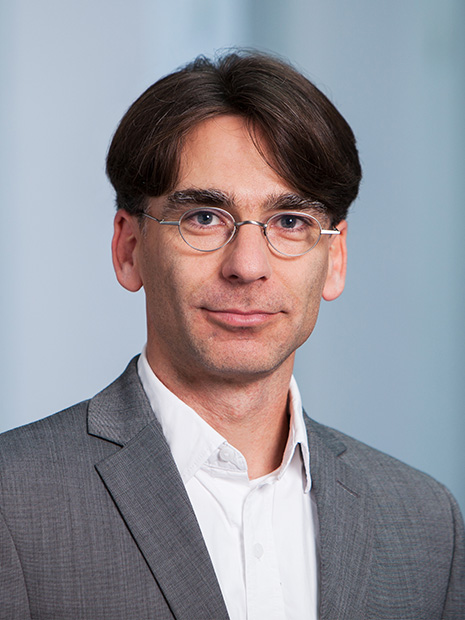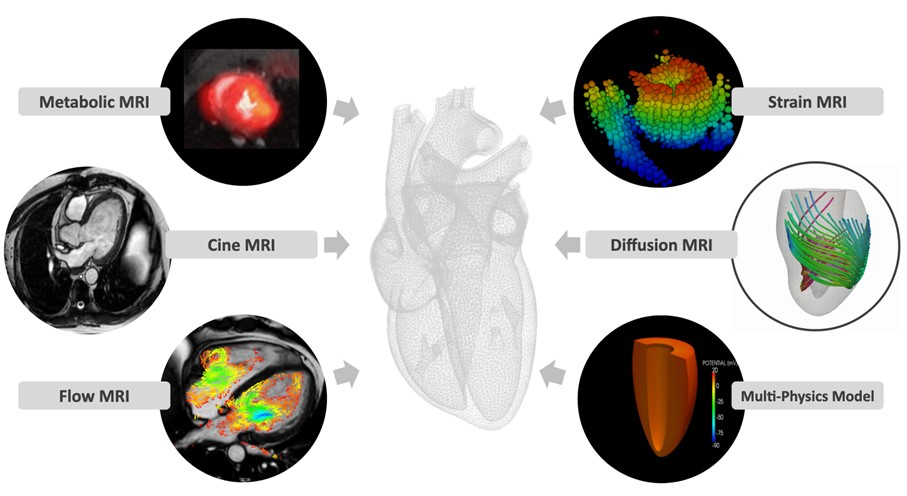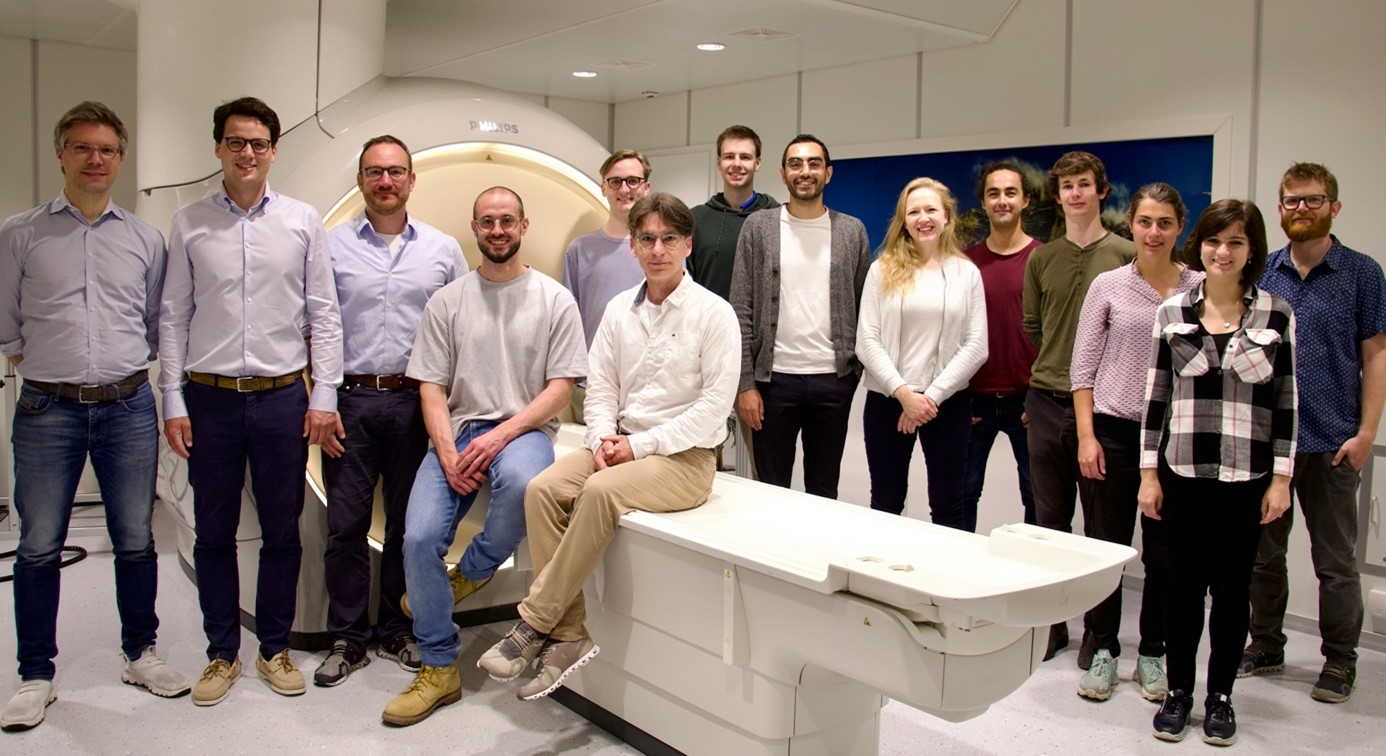“My heart is set on cardiac imaging”
Sebastian Kozerke, professor at the Institute for Biomedical Engineering (IBT), explains in our interview how magnetic resonance imaging and personalised "digital twins" can help in diagnostics and disease prediction in the future. He also talks about what he particularly appreciates about his position as Director of Studies at D-ITET and reveals himself to be a lover of Toblerone mousse at Dozentenfoyer.
Prof. Kozerke, what is your research focus?

My group's research is dedicated to the development of magnetic resonance (MR) imaging and spectroscopy for cardiovascular diagnostics and modelling. We work at the interface between electrical engineering, physics, computer science and medicine to further develop data acquisition, reconstruction, processing and their clinical applications. This includes research at very low temperatures, simulations, machine learning, experiments, but also studies on healthy volunteers and patients. Based on our data, we are developing novel methods that allow us to gain more detailed insights into the anatomy and function of the cardiovascular system. The information, in turn, can be used to create personalised digital twins, i.e. patient-specific organ models which may help in disease predictions and virtual interventions.
What brought you to this field?
After my intermediate diploma in electrical engineering at the TU Berlin, I liked the idea of working in the field of biomedical engineering and I chose corresponding subject combinations in my Master's degree at the University of Karlsruhe (now KIT). In addition, I was interested in medical subjects related to the cardiovascular system and was able to attend additional courses in this area. For me, the combination has been fascinating ever since, as nature shows us how efficiently complex and at the same time very flexible and robust systems can be constructed. During my diploma thesis here at the Institute for Biomedical Engineering, I worked on so-called active contours, a method for segmenting MR images. Subsequently, I was given the opportunity to do my doctoral thesis with Prof. Peter Bösiger in the field of magnetic resonance imaging. Since then, my heart has been set on cardiac imaging.

What impact does your research have on society?
Our goal is to diagnose disorders in the cardiovascular system earlier and more accurately in order to help treat diseases more efficiently or to develop new therapeutic approaches. Faster and more accurate procedures also have an economic component, as they help to reduce costs in the public health sector. We also see opportunities to make information more usable, for example, by having each patient carry their digital twin on their health insurance card so that, among other things, repeated measurements can be avoided or interventions can be prepared in a more targeted manner.
What are currently the biggest challenges in your field of research?
The topic of artificial intelligence in the field of medical diagnostics has developed enormous momentum. At the same time, it is becoming obvious that a deep understanding of what is encoded by imaging – and what is not – is essential. This is how misinterpretations or so-called "overfitting" of a model to given data sets can be avoided. In addition to the further development of information encoding and reconstruction in MR imaging, the topic of "physics-informed neural networks" is also an exciting field of work in order to integrate (bio)physical laws into the field of artificial intelligence. Furthermore, our research is about making magnetic resonance imaging more autonomous, so that this diagnostic procedure can be made available not only in highly developed countries, but also in the developing world.
“The topic of artificial intelligence in the field of medical diagnostics has developed enormous momentum. At the same time, it is becoming obvious that a deep understanding of what is encoded by imaging – and what is not – is essential.”Prof. Sebastian Kozerke
How do you like ETH as a research institution?
The very flat hierarchy, the great collegiality at the Institute, the Department and throughout ETH, the proximity to the University and the University Hospital Zurich, the Toblerone mousse at Dozentenfoyer and the occasional view of the Uetliberg from my office are unbeatable arguments for ETH as an employer.
With which colleagues inside and outside the department do you have collaborations?
Within the department, we work with Klaas Prüssmann, Marco Stampanoni and Ender Konukoglu on the further development of medical imaging and processing. With the D-ITET Center for Project-Based Learning (PBL) and its head Michele Magno, there is cooperation in the field of detection of physiological signals using radar systems. In the field of dynamic nuclear polarisation at low temperatures (-272 degrees Celsius), we cooperate with Matthias Ernst from the Laboratory of Physical Chemistry (D-CHAB). In addition, there is a very close and extremely successful collaboration with clinical colleagues at the University Hospital Zurich (USZ). Under the leadership of Prof. Robert Manka, cardiac MR has been successfully established in clinical care at USZ, including a lively exchange of ideas and personnel.

What is the composition of your group? Are you looking for doctoral students?
My group is quite international and currently includes ten doctoral students (Austria, Italy, Canada, Germany, Switzerland, China), three postdocs (Kuwait, Austria, Italy), two senior assistants (Russia, Germany), as well as two part-time research assistants (Switzerland, Germany) and two part-time physicians (Germany). As some members of the group will soon be finishing their work and we were only able to recruit very few during the pandemic, there is some pent-up demand and accordingly we are now looking forward to receiving new applications.
What lectures are you giving this semester and next semester?
In the Bachelor's programme, we offer "Medical Imaging I+II" for the medical students of ETH each spring; in the Bachelor's and Master's programmes we offer the lectures "Biomedical Imaging" as a core subject and "Anatomy and Physiology I+II for Engineers" (autumn and spring); in the Master's programme, I am involved in the lecture "Biomedical Engineering" (autumn) and I teach the lecture "Magnetic Resonance Imaging in Medicine", my hobbyhorse, each spring. In addition, members of my group offer the lectures "Model- and Learning-Based Inverse Problems in Imaging" and "Theoretical Foundations of Magnetic Resonance Imaging Sequences" each spring.
As Director of Studies at D-ITET, you have been responsible for the implementation of the study programmes since August 2020. Can you give us a few insights into this area of responsibility?
The tasks of the Director of Studies are diverse, but also exciting and part of a team effort to organise and ensure excellent teaching programmes as a core element of ETH's mission. At this point, we would like to expressly thank the study coordination and administration for their commitment and for the cooperation so far! In addition to tasks that run in the background, the Director of Studies interacts with the Rectorate and the Directors of Studies in other departments, and he has the honour of welcoming our first-semester students and bidding a ceremonial farewell to our graduates. It is also an exciting and challenging task to have a helicopter view of the courses and forms of teaching at D-ITET and their future development, also in view of the constantly increasing number of students.
Has the Corona crisis changed teaching permanently? And if so, to what extent?
While the transition from face-to-face to online teaching for information delivery worked well and almost seamlessly in the pandemic, the transition from online teaching to the current hybrid normality is, in my view, less convincing so far and needs further reflection. Without doubt, information can be made available nowadays through various channels and at any time. At the same time, however, I am convinced that efficient and critical processing of information requires interaction between students and between students and lecturers on site. In my experience, the breaks in-between lectures in particular are essential elements in which a lively exchange takes place. Unfortunately, informal and efficient exchange can only be realised with limitations in an online world. In this respect, it is worth considering dividing lectures into offline and face-to-face parts and building in longer "breaks" to enable effective information processing and discussion on site. Experience shows that new ideas, approaches and solutions emerge more often over a coffee together in the real world than in a Zoom session...
